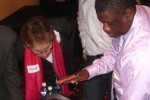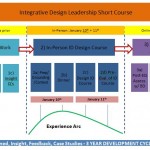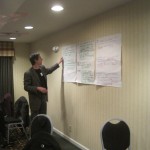Collaborative Learners, Collaborative Leaders
Introduction
CBEI piloted a program that teaches the skills for facilitating Integrative Design (ID) processes for both Advanced Energy Retrofits (AERs) and new construction projects. Held in January 2013, participants planned and executed an ID group project – in this case a group dinner – and then reflected on that experience to reinforce the traits and competencies necessary to aid in an ID project.
This professional development program in Integrative Design Leadership (IDL) was created by CBEI, Pennsylvania State University, and 7Group (integrative design specialists that CBEI engaged to consult on this project). The course was piloted by eighteen specially selected educators and leading integrative design practitioners from across the country, all of whom were involved in some aspect of the building industry and/or integrative systems thinking. The team created the program during a six-month concept development and design phase, and CBEI piloted it on January 10 -11, 2013.
Training the Trainers in Integrative Design Leadership
The team designed the program with a “train the trainer” approach – in which an experienced educator teaches fellow instructors how to deliver a course – in order to build the capacity for educators to teach a future offering of the course, to increase the potential for a larger impact by enabling instructors to embed elements of the program into the their existing courses, and to gain insight into how to improve this course for the next offering. Thus, the primary objective of the two-day pilot program at the Navy Yard was to teach the participants how to design, implement, and deliver their own integrative design courses.
To prepare participants for the in-person portion of the course, participants completed portions of the program remotely prior to January’s face-to-face course. The prerequisites included watching video-based integrative design case studies and reviewing the newly developed American National Standards Institute (ANSI) Standard for Integrative Design.

Participants also completed an Emotional Intelligence (EQ-i) assessment prior to the in-person portion of the course, in order to gain self-awareness on particular, people-focused integrative design competencies. An EQ-i assessment evaluates an individual’s ability to identify, assess, and manage his or her own emotions, the emotions of others, and the emotions of the groups with which one is engaged.
In January, participants came together for the in-person portion of the course, where they were introduced to the fundamental models for integrative processes and the application of these models. The information was communicated to the participants in a hands-on and immersive experience in integrative design.
Applying Integrative Design Practices
The January course engaged the participants in collectively planning and executing (i.e. cooking) a group dinner. The course designers elected to have the group prepare a dinner, because a meal has meaning and value to everyone, regardless of professional background. This concept of shared values is essential to building and maintaining one’s willingness to engage in a project.
Overall the course followed an integrated design framework organized around developing a purpose, defining products and establishing a process. Participants began their meal “design” by setting a purpose statement to capture the course’s function of creating a meal, to define the way in which the team is to meet its objective, and to express the motivation for taking on the effort. The participants then created a menu and an organization chart that assigned tasks to each participant.
The pilot course group’s holistic purpose statement was:
- To use energy efficiency as a leveraging instrument for developing integrative process core competencies aimed at transforming the building industry workforce (the functional statement)
- In a way that that participants experience energizing interactions that foster renewed connections with their values, sense of purpose, meaning, and potential (the “being” part of the statement)
- So that participants develop their leadership capacity and capability for facilitating and activating economic, human, and ecological health indefinitely (the “will”/motivation statement)
The course included a carefully designed change of plans – or “big bump” – to provide an opportunity to experience and evaluate how ID handles an unforeseen project change. The “big bump” was the unexpected, last-minute addition of four Architecture and Engineering students to the dinner, which forced the course participants to alter their well-laid plans. Participants reoriented around their purpose statement before updating their menu and work process to accommodate the additional guests.
On the second day of the course, participants reflected upon the integrative process they experienced on day one and used the insight to begin designing their own course. They evaluated how the principles and techniques they used throughout the previous day would work in a real-world situation. They also examined their personal EQ-i when dealing with an unexpected change.
After the course, the participants were asked to evaluate their experience. One participant summarized his/her experience in this way,
It gave me a sense of confidence that I did not have before the training. I attribute this to the exercises which helped us to think about ‘how we were thinking,’ which enabled me to see my role and character traits much more clearly amongst a diverse set of stakeholders on a design and construction team. I also learned that my role/character traits are not static but must be iterative throughout the entire process and I will be working hard over the next several months to strengthen my ability to transition between ‘visionary,’ ‘supporter,’ ‘analyzer,’ etc .
Future Goals for the IDL Program
CBEI intends to replicate this program throughout the Greater Philadelphia region. Pilot program participants will be engaged as trainers in at least three new offerings of the program for diverse audiences. In addition, program leaders hope to build upon the U.S. Green Building Council’s (USGBC) participation in the pilot IDL program. There is potential to incorporate the IDL program into the next generation of USGBC professional development programs and credentials.




